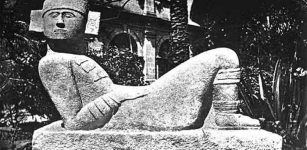Mysterious Mohenjo Daro Was Home To An Unknown Advanced Civilization Far Ahead Of Its Time
A. Sutherland - AncientPages.com - Thousands of years ago, the mysterious city of Mohenjo Daro was home to an unknown, advanced and prosperous civilization that used technology and constructed buildings that were unique to the ancient world.
Artifacts, relics and ruins reveal startling evidence that the inhabitants of Mohenjo Daro possessed inventions that were far ahead of their time.
How and from whom did these remarkable people acquire knowledge of such sophisticated technology?
Why did this enigmatic civilization vanish? The history of the ancient world is full of secrets.
Can some of the interesting archaeological discoveries cast more light on what really happened to one of the world's oldest and advanced civilizations?
The ruined great city of Mohenjo-Daro ("Mound of the Dead") was once a major urban center of the Harappa Culture or Indus Civilization, a highly developed civilisation that flourished on the banks of the rivers Indus and Saraswati, around 3000 BC. (in Pakistan now)
Excavations in 1920-22 at Harappa -Mohenjodaro (which lie in what is now Pakistan) confirmed the existence of an unknown civilization in the Indus Valley, the home of one of the oldest highly advanced civilizations of the world.
The sophistication of the infrastructure relating to the water supply and effluent disposal systems of the mysterious city was unique!
Why was Mohenjo-Daro abandoned?
The Indus Civilization collapsed around 2000 BC Mohenjo-Daro - discovered in 1922 - was a center of trade and manufacture built on two gigantic artificial mounds; a higher mound the so-called citadel or acropolis overlooked the lower mound considered as residential with hundreds of dwelling houses, larger buildings and a regular system of streets.
Mohenjo-Daro's infrastructute displaced very advanced techniques focused on water supply and effluent disposal systems, extremely important for public health.
This prehistoric society valued good roads, clean fresh water and a system of law.
Probably the most impressive building was a bath-house having absolutely no equal in cities until the Roman period. It was covered with a pool measuring 40 feet by 23 feet, with a steam-bath and a hot-air heating system.
When the city flourished, fresh water was supplied by a network of over 700 unique wells for drinking water, constructed in form of cylindrical shafts several meters deep.
Mohenjo-Daro's citizens used them long before Egypt and Mesopotamia, where water was still fetched from rivers to be stored in cisterns.

The Dancing Girl, the iconic bronze figurine of Mohenjodaro. (Benoy K. Behl/Collection: National Museum, New Delhi)
The city's engineers and masons also built bathrooms in every home while polishing the tiles of its grand ritual bath to a highly burnished waterproof glaze.
Unique water supply from wells was integrated with a drainage system. Waste water along with sewage from houses was channeled into a complex system of drains running along and below the streets.
The drains had removable covers to give access for cleaning. Cesspools and soakaway pots were commonly used and each bedroom had running water and a bathroom and lavatory.
The municipal sewerage was so efficient that according to British engineers, they could do no better at the present day.
Some interesting terracotta female figurines of the so-called "mother goddess" have been discovered at Mohenjo-Daro.
One of these figurines, dated to approximately 3000 BC, depicts a woman wearing extremely short mini skirt, a necklace and belt and only her face is rather strange and very unusual.
Was she looking like this, when this clay figurine was formed? Was it her real appearance?
If this was the case, one can say that the civilization of Mohenjo Daro had a lot in common with our modern society.
Among more than 40,000 artifacts unearthed in Mohenjo-Daro, there are hand-carved chess pieces, perfectly clay toy animals, and clay urns, platters, and ovens that highlight a culinary culture and stone weights and measures.
When the 5,000-year-old ruins of the city were first unearthed, it was one of the greatest archaeological discoveries. Today Mohenjo-Daro's situation is not is in danger to be completely destroyed and forgotten.
According to archaeologists, Mohenjo-Daro will most probably disappear within 20 years without an urgent rescue plan. If this happens, an important and valuable piece of our history will be lost.
Written by – A. Sutherland AncientPages.com Staff Writer
Copyright © AncientPages.com All rights reserved. This material may not be published, broadcast, rewritten or redistributed in whole or part without the express written permission of AncientPages.com
More From Ancient Pages
-
 A Remarkably Well-Preserved Wooden Well Dating Back To The Bronze Age Uncovered In Benson, Oxfordshire
Archaeology | May 10, 2024
A Remarkably Well-Preserved Wooden Well Dating Back To The Bronze Age Uncovered In Benson, Oxfordshire
Archaeology | May 10, 2024 -
 Oldest Known Fossil Footprints Discovered On Crete By Polish Researcher Challenge Established Theories Of Human Evolution
Archaeology | Nov 11, 2017
Oldest Known Fossil Footprints Discovered On Crete By Polish Researcher Challenge Established Theories Of Human Evolution
Archaeology | Nov 11, 2017 -
 ‘Dates Add Nothing To Our Culture’: Everywhen Explores Indigenous Deep History, Challenging Linear, Colonial Narratives
Featured Stories | Mar 10, 2023
‘Dates Add Nothing To Our Culture’: Everywhen Explores Indigenous Deep History, Challenging Linear, Colonial Narratives
Featured Stories | Mar 10, 2023 -
 4,000-Year-Old Textile Mill Discovered At Beycesultan Mound In Western Turkey
Archaeology | Sep 25, 2020
4,000-Year-Old Textile Mill Discovered At Beycesultan Mound In Western Turkey
Archaeology | Sep 25, 2020 -
 Tailteann Games: Ancient Irish Version Of The Olympic Games
Ancient History Facts | May 15, 2016
Tailteann Games: Ancient Irish Version Of The Olympic Games
Ancient History Facts | May 15, 2016 -
 Fortified Bronze Age City Filled With Magnificent Ancient Treasures Solves A Mystery In China
Archaeology | Nov 21, 2023
Fortified Bronze Age City Filled With Magnificent Ancient Treasures Solves A Mystery In China
Archaeology | Nov 21, 2023 -
 Bolivia And The Mystery Of The Twins Of Atlantis
Ancient Mysteries | Nov 16, 2014
Bolivia And The Mystery Of The Twins Of Atlantis
Ancient Mysteries | Nov 16, 2014 -
 Kültepe: Once Part Of The Kingdom Of Hittites And The Center of a complex network of Assyrian trade colonies in the 2nd millennium B.C.
Civilizations | Oct 16, 2015
Kültepe: Once Part Of The Kingdom Of Hittites And The Center of a complex network of Assyrian trade colonies in the 2nd millennium B.C.
Civilizations | Oct 16, 2015 -
 Chacmool (‘Chac-Mool’) – Intriguing Pre-Columbian Statue Found At Many Ancient Sites In Mesoamerica
Featured Stories | May 22, 2021
Chacmool (‘Chac-Mool’) – Intriguing Pre-Columbian Statue Found At Many Ancient Sites In Mesoamerica
Featured Stories | May 22, 2021 -
 Ancient Giant Amphibians Swam Like Crocodiles 250 Million Years Ago – New Study
Archaeology | Mar 31, 2023
Ancient Giant Amphibians Swam Like Crocodiles 250 Million Years Ago – New Study
Archaeology | Mar 31, 2023 -
 Ur – One Of The Largest And Most Important Cities Of Ancient Mesopotamia
Featured Stories | Jul 28, 2021
Ur – One Of The Largest And Most Important Cities Of Ancient Mesopotamia
Featured Stories | Jul 28, 2021 -
 Årsgång – Year Walk In The Forest – Mystical Journey To Gain Knowledge About The Future – An Ancient Swedish Ritual
Ancient Traditions And Customs | Jan 1, 2025
Årsgång – Year Walk In The Forest – Mystical Journey To Gain Knowledge About The Future – An Ancient Swedish Ritual
Ancient Traditions And Customs | Jan 1, 2025 -
 Bill Of Rights 1689 – Enormous Historical Moment In English History
Ancient History Facts | May 6, 2019
Bill Of Rights 1689 – Enormous Historical Moment In English History
Ancient History Facts | May 6, 2019 -
 Strange Underwater Mini-Pyramid Older Than Stonehenge With Unknown Purpose – Who Built It?
Ancient Mysteries | Sep 12, 2021
Strange Underwater Mini-Pyramid Older Than Stonehenge With Unknown Purpose – Who Built It?
Ancient Mysteries | Sep 12, 2021 -
 Huge Ancient Hydraulic System Built By The Liangzhu Culture May Be World’s Oldest And Predate Mesopotamian Water Systems
Ancient Technology | Dec 9, 2017
Huge Ancient Hydraulic System Built By The Liangzhu Culture May Be World’s Oldest And Predate Mesopotamian Water Systems
Ancient Technology | Dec 9, 2017 -
 Strange Engraving Made By Knights Templar In French Village – It Doesn’t Make Sense Or Does It? – Part 2
Ancient Mysteries | Oct 9, 2019
Strange Engraving Made By Knights Templar In French Village – It Doesn’t Make Sense Or Does It? – Part 2
Ancient Mysteries | Oct 9, 2019 -
 Magical Cap Of Invisibility Worn By Athena, Hades, Hermes, And Perseus
Featured Stories | Mar 25, 2019
Magical Cap Of Invisibility Worn By Athena, Hades, Hermes, And Perseus
Featured Stories | Mar 25, 2019 -
 The Apaches’ Mysterious Encounter With Unknown Beings
Featured Stories | Jun 10, 2024
The Apaches’ Mysterious Encounter With Unknown Beings
Featured Stories | Jun 10, 2024 -
 Tāne: Lord Of The Forest Who Brought Three Baskets Of Knowledge To People In Maori Mythology
Featured Stories | Feb 17, 2025
Tāne: Lord Of The Forest Who Brought Three Baskets Of Knowledge To People In Maori Mythology
Featured Stories | Feb 17, 2025 -
 Has The Mysterious Lost Capital Of The Ancient Kingdom Of Lyncestis Been Unearthed In Northern Macedonia?
Archaeology | Apr 11, 2025
Has The Mysterious Lost Capital Of The Ancient Kingdom Of Lyncestis Been Unearthed In Northern Macedonia?
Archaeology | Apr 11, 2025






